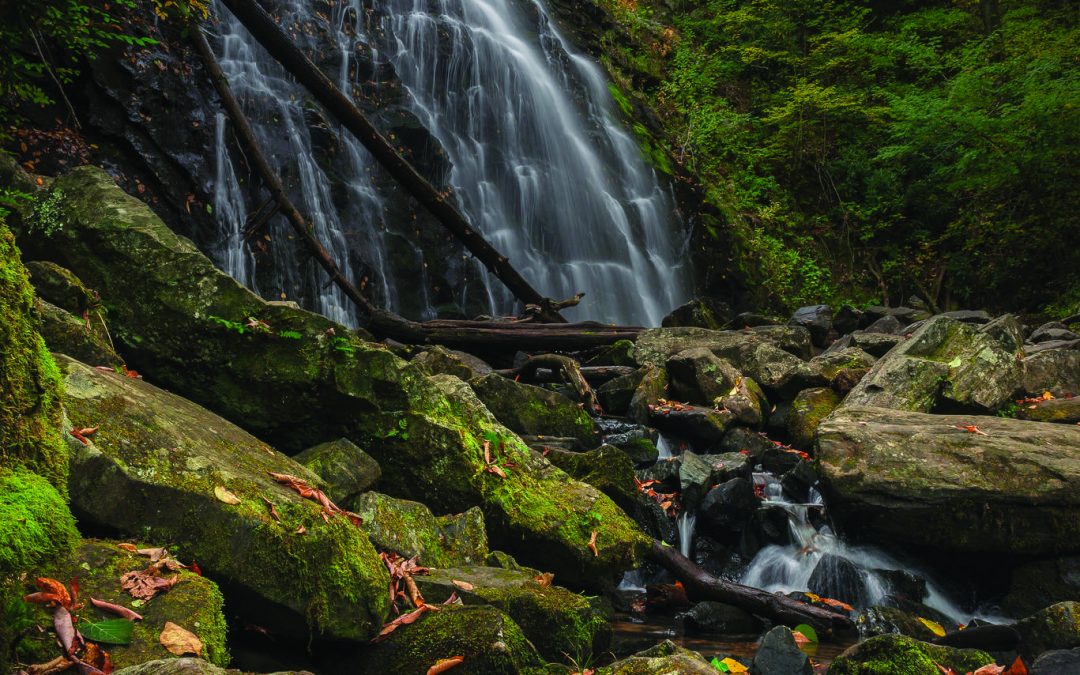Many of the hiking trails in the Parkway feature beautiful views, such as in this photo of Crabtree Falls (Ken Lane).
There’s a reason the Blue Ridge Parkway is America’s most visited National Park Service site. The 469-mile road does more than connect the Great Smoky Mountains National Park in North Carolina to Shenandoah National Park in Virginia. It is both a fascinating display of the nation’s history and a gorgeous landscape to explore. It is renowned for its beauty and for its peaceful natural atmosphere—even though it is a popular vacation spot, the park is large enough that it feels secluded and peaceful.
One of the reasons the Blue Ridge Parkway attracts so many visitors is its universal appeal; it really does have something for everyone. Because of the variety of options for experiencing the parkway—you can camp or stay in a rustic hotel; hike, bike, or just stay in the car; and visit the entire parkway or just a small stretch—it is a perfect vacation for people of all ages and activity levels. It is one continuous road with no offshoots, other than exits to leave the park. Along the sides of the road are mile markers, which correspond with guidebooks to help visitors identify where the trails, overlooks, and campsites are.
History
The parkway was originally conceived in 1933 by US senator Henry Byrd. Franklin Delano Roosevelt saw the potential of Byrd’s idea, and the Civilian Conservation Corps began construction of the parkway two years later in North Carolina. Most of the parkway was completed in 1966; however, it took an additional 21 years for the last 7.7 miles of the road to be completed. The Linn Cove Viaduct was the final piece of the parkway, constructed in 1987 using revolutionary technology to wind around Grandfather Mountain without damaging the iconic mountain. The parkway was finally complete.
Today
Today, the parkway preserves a beautiful landscape replete with hiking trails and tree-filled, mountainous overlooks. Although most famous for its fall scenery, when the colorful leaves draw the most visitors, it is beautiful year-round. The Blue Ridge Parkway does close in the winter, however, because it would be too difficult for the National Park Service to clear any ice and snow. In the spring, waterfalls and streams are particularly awe-inspiring thanks to the winter’s snow melt, and wildflowers bloom across the parkway. No matter what time of year you visit, you are sure to have a memorable experience.
Sites along the Parkway
The National Park Service owns much of the land surrounding the road in North Carolina, but in parts of Virginia the road is surrounded by ordinary farms. However, both states boast popular visitor sites. In Virginia, where the Blue Ridge Parkway starts, notable sites include the James River, where visitors can hike, camp, and fish; Mabry Mill, which features historical exhibits about life in rural Virginia, hiking trails, and a diner known for its pancakes; and the Blue Ridge Music Center, where the sound of folk and bluegrass music can almost always be heard, played by local musicians. The North Carolina portion of the parkway includes even more sights: Cumberland Knob, a natural landscape and the site where construction started in 1935; Moses H. Cone Park, which features a late nineteenth century manor overlooking hiking trails, horse trails, and a pristine lake; Linn Cove Viaduct; the Folk Art Center and the Blue Ridge Parkway Visitor Center; and Mount Pisgah, which features a 16-mile hiking trail, beautiful views, and the Pisgah Inn and its restaurant. Additionally, it is nearly impossible to drive more than a few miles along the parkway without encountering a hiking trail or overlook, and there are beautiful views from the entire road. The hikes range from short leg-stretchers to rigorous excursions, and from well-traveled routes to overgrown, secluded paths.
The Blue Ridge Parkway is something everyone should experience at least once; it has so many options that there is something for any type of interest. Visiting the parkway will allow you to see pristine mountains and beautiful forests. You likely won’t be able to visit just once; the the parkway’s immense size allows visitors to come again and again, and still experience something new each time. The Blue Ridge Parkway is “America’s Favorite Drive,” and it will certainly become one of yours too.
-Alexandria Despain

